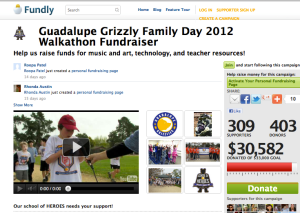The recent controversy surrounding women’s choice to stay home or pursue a career brings to mind something I’ve observed and embraced these past few years as a mom of school-aged children. Regardless of each person’s own choice, it takes that proverbial village to raise a child and to provide the support needed to bolster that child’s school experience. There’s not only room for but need for both the moms who stay at home and the moms who work, within the school support ecosystem.
As a Kindergarten parent I found that, overwhelmingly, parents wanted to be involved in their kids’ education. Families with one parent at home tended to have more time but less money to give to support the school. Families with both parents or a single parent working tended to have less time but more money to give. Each parent had value, which served the school and its students best when pooled.
But the idea of combining forces for good broke down to a degree because we weren’t reaching both “sects” of the school’s families.
Communication within the school’s Home & School Club (a non-association version of a PTA) was not doing a proper job of making the most of what every family had to offer. The main methods of communication in play, drop-off/pick-up time conversations, posters on classroom doors, and a paper flier envelope system, kept the moms who were regularly at school the most in the loop. This wasn’t in any way a premeditated approach but one of convenience. Key parent organization roles were held by moms who either stayed at home or worked part-time, allowing them more time to be present at school to plan the next school fundraising event or lend a hand in the classroom. Parents whose work schedules required their kids be in after-school care were uninformed of many opportunities to help the school simply because they weren’t where the information was.
It was the beginning of tough economic times in the US, 2008-2009. Fundraising and volunteerism needed a kick-start, and making sure the whole school community was tuned to the needs was key. Change was in order.
We expanded the reach of Communication.
- We launched a new email newsletter alongside the traditional Wednesday envelope. We found immediately that parents were reading the weekly messages we sent in great numbers, from their desks at work, their mobile devices, and from home in that sacred hour of peace once the kids were nestled all snug in their beds. Using an email marketing program (Constant Contact, MailChimp, and Vertical Response are a few good ones) allowed our Home & School Club to gauge the effectiveness of our messages and keep our parent email list up-to-date.
- Adding links to online volunteer sign-ups (Jooners and VolunteerSpot are a couple to check out) resulted in immediate commitments of time and skill from both working and stay-at-home parents. Something as fundamental and meaningful to students as the class Halloween party was opened up to online sign-ups to allow busy moms to contribute a hand or send a dish.
As families took to online communication, the stacks of paper that once accumulated on the kitchen counter dwindled to a few sheets highlighting key information. Overall, parents became better informed and more involved. Both stay-at-home parents and those commuting to work everyday focused on the communication method that best suited their lives. Not just because we went online, but because we gave parents better and more succinct information in a form relevant to their world of chaos(!).
We expanded School Fundraising. When it came to the increasing challenge of funding school programs, online fundraising made greater fundraising possible.
- To give the Annual Giving Drive a boost, we offered an alternative to writing a check through online fundraising, reaching dual-income families with convenient one-time credit card payments and giving families on tighter budgets the option to make automatic recurring payments throughout the school year. About 40% chose online fundraising and averaged significantly higher donations than those writing checks.
- The School Walkathon presented an even better avenue to increased donations. Since walkathons are designed around the concept of gathering pledges to support a student’s effort, online fundraising was the perfect play. We needed to make it easy for parents to reach more supporters and convenient for supporters to donate, versus the traditional cash/check approach. Again, more than 40% of families opted for online, resulting in more than twice the level of donations we received on paper. We were seeing donations from North Carolina, Illinois, Texas, California, Canada, Spain, Japan, Guam, and even New Zealand. Talk about going global!

While still a work in progress, three years later our school is better in sync and able to handle growing volunteer and funding needs because we’ve taken the care to address and welcome the value of both stay-at-home moms and working moms (and the dads who also deserve credit!).
And since, I’ve had the fulfilling experience of guiding other schools to successfully navigate the shift to online communication and online fundraising.
I’m particularly excited to be a part of Fundly’s 12 Schools in 12 Weeks Challenge to give schools the chance to increase their walkathon (and other a-thon) fundraising with one-on-one support and professionally-developed communications.
Every mom is valuable, not only at home but at school. The key is to embrace what each brings to the table, whether time, experience, skill, resources, or money, and create an environment where every parent is in the loop on their kid’s education. Just for kicks, calculate your mom’s work worth and remember that everything you make the effort to give makes a difference at your local school.

